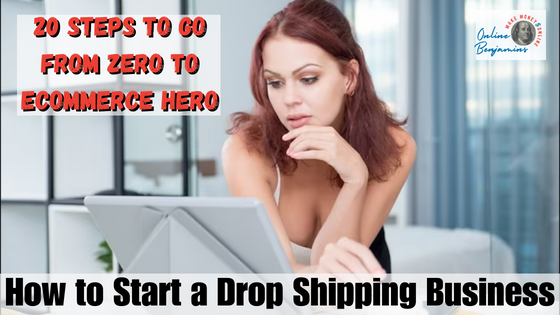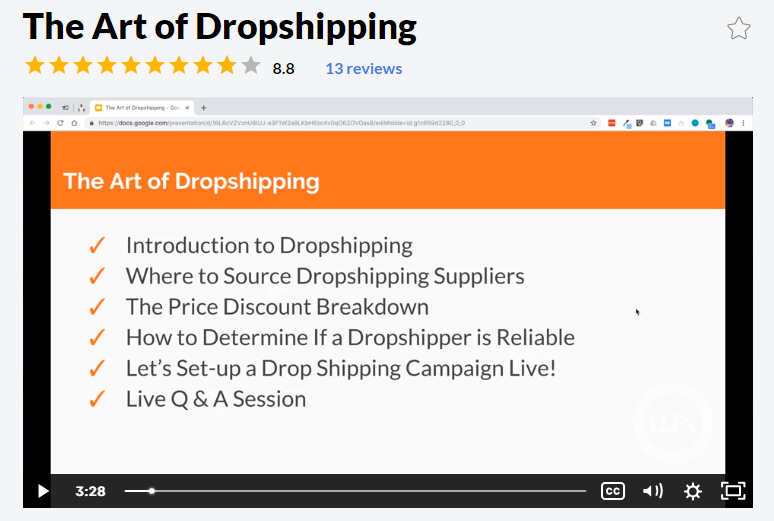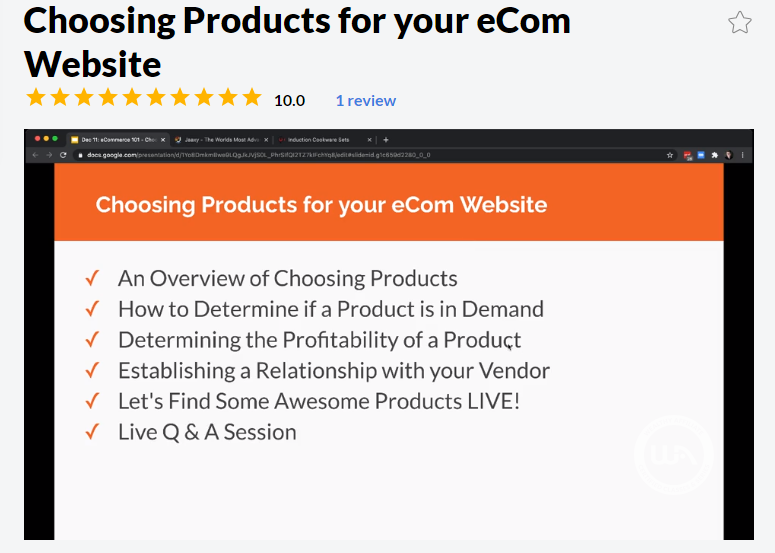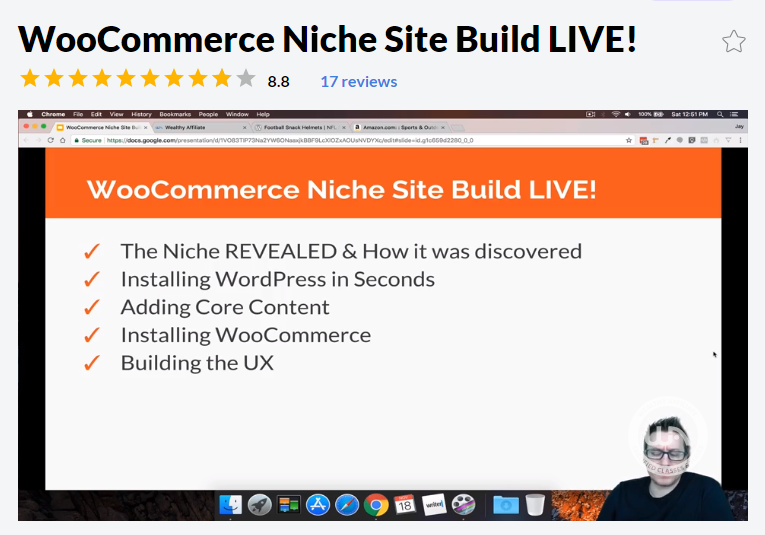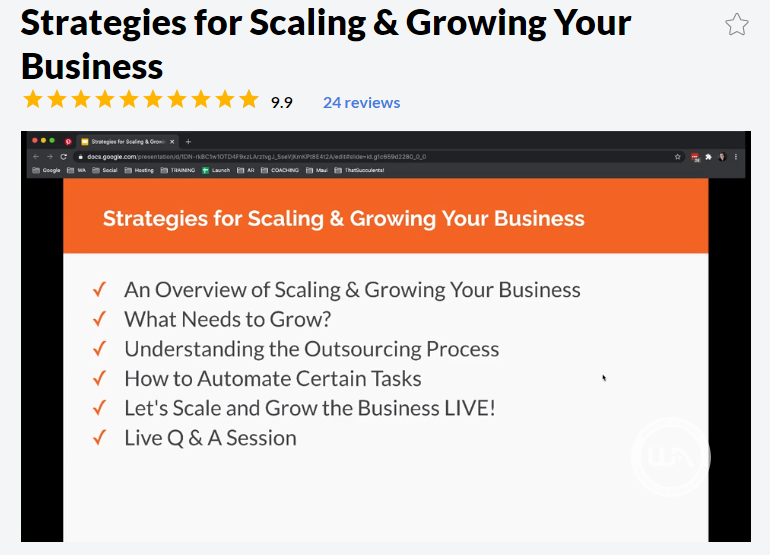Starting a drop shipping business can be an exciting and profitable venture. It allows you to sell products without having to hold any inventory or manage shipping. Instead, you work with a supplier who ships the products directly to your customers.
But, before you start a drop shipping business, you need to understand the basics of the model and plan carefully. You’ll need to choose a niche, find reliable suppliers, and create a user-friendly online store to showcase your products. Once your store is up and running, you’ll need to promote it to attract customers and manage your orders efficiently.
Follow along and we’ll guide you through the steps to start a drop shipping business. From understanding the basics of drop shipping to scaling your business, we’ll cover everything you need to know to get started. By the end of this article, you’ll have a clear road map for launching your own successful drop shipping business. And, we’ll take a quick look at Affiliate Marketing as a possible alternative.
Key Takeaways
- Learn and understand the basics of drop shipping and plan carefully.
- Choose a niche, find reliable suppliers, and create a user-friendly online store.
- Promote your store to attract customers and manage your orders efficiently.
- Continue to learn and keep up with trends and market changes
Understanding Drop Shipping
What is Drop Shipping?
Drop shipping is a retail fulfillment method where a store doesn’t keep the products it sells in stock. Instead, when a store sells a product, it purchases the item from a third party and has it shipped directly to the customer. As a result, the merchant never sees or handles the product.
The process of drop shipping works as follows:
- You find a supplier that offers drop shipping services.
- You list their products on your website or online marketplace.
- Your customers place orders on your website or online marketplace.
- You collect payment from your customers.
- You forward the order information to your supplier and pay them for the product.
- Your supplier ships the product directly to your customer.
- You pocket the difference between your retail price you charge customers and the wholesale price you pay your suppliers.
Is drop shipping a legal and legitimate business model?
Drop shipping is a legal and legitimate business model that allows online retailers to sell products without having to stock or ship them themselves. Instead, they partner with third-party suppliers who handle the inventory, fulfillment, and shipping of the products to the customers.
Drop Shipping Potential Legal Issues

This way, the retailers can focus on marketing, customer service, and growing their businesses. You need to keep in mind however, drop shipping also comes with some legal risks that need to be considered and avoided. Some of these risks are:
Selling counterfeit or trademarked products. Some suppliers may offer products that infringe on the intellectual property rights of other brands or companies. This can result in legal action, fines, or lawsuits from the owners of the trademarks or copyrights. To avoid this, retailers should always verify the authenticity and quality of the products they sell and work with reputable and authorized suppliers.
Failing to comply with tax laws. Depending on the location of the retailer, the supplier, and the customer, different tax laws may apply to each transaction. Retailers need to be aware of their tax obligations and collect and remit the appropriate sales taxes, VAT, GST, or other taxes to the relevant authorities. To avoid this, retailers should consult with a tax professional or use a tax automation software to calculate and file their taxes correctly.
Misleading customers or violating advertising laws. Some retailers may be tempted to make false or exaggerated claims about their products or services to attract more customers or increase conversions. However, this can result in customer complaints, refunds, chargebacks, or legal action from consumer protection agencies or regulators. To avoid this, retailers should always be honest and transparent about their products, prices, policies, and delivery times and follow the truth in advertising laws of their jurisdictions.
Pros and Cons of Drop Shipping
| The Pros of Drop Shipping |
|---|
| Low startup costs: Since you don’t need to purchase inventory upfront, you can start a drop shipping business with very little money. |
| No Inventory: You don’t have to worry about storing, managing, or tracking inventory. |
| Flexible location: You can run a drop shipping business from anywhere, as long as you have an internet connection. |
| Wide product selection: You can sell a wide variety of products without having to purchase them upfront. |
| Low risk: If a product doesn’t sell, you’re not stuck with unsold inventory. |
| The Cons of Drop Shipping |
|---|
| Lower profit margins: Since you’re not buying products in bulk, you’ll pay more for each product, which can lower your profit margins. |
| Less control over the shipping process: Since you’re relying on a third party to ship your products, you have less control over the shipping process. |
| Shipping costs: You’ll need to factor in shipping costs when setting your prices, which can eat into your profit margins. |
| Supplier issues: If your supplier runs out of stock or goes out of business, it can cause problems for your business. |
| Customer service: If a customer has an issue with their order, you’ll need to work with your supplier to resolve the issue, which can be time-consuming. |
Planning Your Drop Shipping Business
Drop shipping is a business model where you sell products online without having to handle inventory, fulfillment, or shipping. It sounds like a dream, right? You just need to find a product niche, set up a website, and start marketing to your target audience. But how do you actually start a drop shipping business? Before you start your drop shipping business, you need to plan it out. In this section, Here are some steps you should take to plan your business.
Identifying Your Niche
The first step in planning your drop shipping business is to identify your niche. A niche is a specific segment of the market that you want to target with your products. For example, you could sell pet accessories, fitness equipment, or home decor. You need to decide what products you will sell and who your target customers will be.
To do this, think about your interests, hobbies, and passions. You should choose a niche that you are passionate about, as this will make it easier for you to market and sell your products. Choose a niche. Choosing a niche will help you focus your marketing efforts and stand out from the competition.
Once you have identified your niche, you need to research it thoroughly. Look at your competitors and see what they are doing. Look at their products, pricing, and marketing strategies.
You should also research the demand, profitability, and competition of your niche before you commit to it. This will give you an idea of what is working in your niche and what is not.
Market Research
Market research is a critical step in planning your drop shipping business. You need to understand your target market and their needs. This will help you to create a marketing strategy that will resonate with your customers.
To conduct market research, you can use online tools like Google Trends and Facebook Insights or even AI tools like ChatGPT. These tools will help you to understand what people in your niche are searching for and what they are interested in. You can also conduct surveys and focus groups to get feedback from your target customers.
Business Model Selection
The final step in planning your drop shipping business is to choose your business model. There are two main business models for drop shipping: niche-focused and general store.
A niche-focused store sells products in a specific niche, such as pet supplies or yoga equipment. A general store sells products in multiple niches. Both models have their pros and cons, so you need to choose the one that is right for you.
Once you have chosen your business model, you need to create a business plan. This should include your niche, target market, marketing strategy, and financial projections. By following these steps, you can plan your drop shipping business and set yourself up for success.
Setting Up Your Drop Shipping Business
When it comes to setting up your drop shipping business, there are a few key steps you’ll need to take. The following steps are: the legalities and documentation you’ll need to consider, how to create a business plan, and how to choose your suppliers.
Legalities and Documentation
Before you can start your drop shipping business, you’ll need to make sure you have all the necessary legal documentation in place. This includes registering your business, obtaining any necessary permits or licenses, and setting up your tax structure. You may also want to consider creating a legal agreement with your suppliers to protect yourself and your business.
Here are some key legal considerations to keep in mind:
- Business registration: Register your business with your state or local government.
- Permits and licenses: Check with your local government to see if you need any permits or licenses to operate your business.
- Tax structure: Set up your tax structure and obtain any necessary tax IDs.
- Legal agreements: Consider creating a legal agreement with your suppliers to protect your business.
Business Plan
Creating a business plan is an essential step in setting up your drop shipping business. Your business plan should include your goals, target market, marketing strategy, financial projections, and more. It will serve as a road map for your business and help you stay on track. And, in the event you wish to borrow money to fund your business, banks will want to see your business plan.
Here are some key elements to include in your business plan:
- Executive summary: A brief overview of your business and its goals.
- Market analysis: An analysis of your target market and your competition.
- Marketing strategy: A plan for how you will market your business and attract customers.
- Financial projections: Projections for your revenue, expenses, and profits.
- Operations plan: A plan for how you will run your business day-to-day.
Choosing Your Suppliers
A supplier is the company that will provide you with the products that you want to sell. You can use platforms like AliExpress, Spocket, or SaleHoo to find suppliers that offer drop shipping services. Choosing the right suppliers is crucial for the success of your drop shipping business.
You’ll want to find reliable suppliers who offer high-quality products at a reasonable price. You’ll also want to consider factors like shipping times, return policies, and customer service. Here are some key factors to consider when choosing your suppliers:
- Product quality: Make sure your suppliers offer high-quality products that meet your customers’ expectations.
- Pricing: Look for suppliers who offer competitive pricing.
- Shipping times: Consider the shipping times offered by your suppliers and make sure they align with your customers’ expectations.
- Return policies: Make sure your suppliers have clear and fair return policies.
- Customer service: Look for suppliers who offer excellent customer service and are responsive to your needs.
By following these steps, you’ll be well on your way to setting up a successful drop shipping business.
Building Your Online Store
When it comes to building your online store, there are a few things to keep in mind, like website creation, product listing, and payment and shipping options.
Website Creation
A website is where you will showcase your products and accept orders from your customers. You can use platforms like Shopify, WordPress, WooCommerce, or BigCommerce to create your own online store without any coding skills. You should choose a domain name that reflects your brand and niche, and design your website to be user-friendly and attractive. Your website is the foundation of your online store, so it’s important to get it right. Things to consider when creating a website that will help you succeed:
- Choose a platform that’s easy to use and customize. Popular options include Shopify, WooCommerce, and BigCommerce.
- Pick a design that’s clean and professional. Avoid clutter and make sure your site is easy to navigate.
- Make sure your site is mobile-friendly. Many customers will be shopping on their phones, so it’s important to have a site that looks good on all devices.
Product Listing
Once you have your website set up, it’s time to start listing your products. Here are a few things to keep in mind:
- Choose products that are in demand and have a high profit margin. Use tools like Google Trends and Amazon Best Sellers to research popular products.
- Write clear and detailed product descriptions. Include information about the product’s features, dimensions, and materials.
- Use high-quality images that show the product from multiple angles. Customers want to see what they’re buying, so make sure your images are clear and well-lit.
Payment and Shipping Options
Finally, you’ll need to set up payment and shipping options for your store. Here are a few things to consider:
- Offer multiple payment options, including credit cards, PayPal, and Apple Pay. Make sure the checkout process is easy and secure.
- Choose a reliable shipping partner that offers tracking and insurance. Offer multiple shipping options, including standard and expedited shipping.
- Make sure your shipping rates are competitive. Research what other stores are charging for shipping and adjust your rates accordingly.
By following these tips, you’ll be well on your way to building a successful dropshipping business.
Marketing Your Drop Shipping Business
Once you have set up your dropshipping business, it’s time to start marketing it. Marketing your business is crucial to its success. In fact, marketing is how you will attract customers to your website and generate sales. You can use various strategies like social media, email marketing, content marketing, SEO, or paid ads to promote your products and brand.
You should also optimize your product pages with clear descriptions, images, and prices, and provide excellent customer service to build trust and loyalty with your customers for repeat sales. Here are some effective marketing strategies to help you get started.
SEO and Content Marketing
Search Engine Optimization (SEO) is a critical component of any online marketing strategy. It is the process of optimizing your website and content to rank higher in search engine results pages. Content marketing is the practice of creating and sharing valuable content to attract and retain customers.
To improve your SEO, you should focus on creating high-quality content that is relevant to your target audience. Use keywords that your audience is searching for in your content. Make sure your website is optimized for search engines by using meta tags, alt tags, and header tags.
Social Media Marketing
Social media marketing is an effective way to promote your dropshipping business. Social media platforms like Facebook, Twitter, and Instagram allow you to reach a large audience. You can use social media to build brand awareness, engage with your audience, and drive traffic to your website.
To be successful with social media marketing, you should create a social media strategy. Identify which social media platforms your target audience is using and create content that is tailored to each platform. Use hashtags to increase your reach and engage with your followers by responding to comments and messages.
Email Marketing
Email marketing is a cost-effective way to promote your dropshipping business. It allows you to reach your audience directly and promote your products or services. You can use email marketing to build relationships with your customers, promote new products, and drive sales.
To be successful with email marketing, you should build an email list of subscribers who are interested in your products or services. Offer incentives like discounts or freebies to encourage people to sign up. Segment your email list to send targeted emails to specific groups of subscribers. Use eye-catching subject lines and include a clear call-to-action in your emails.
By implementing these marketing strategies, you can effectively promote your dropshipping business and drive sales. Remember to track your results and adjust your strategy as needed to achieve the best results.
Managing Your Drop Shipping Business
Once your drop shipping business is up and running, you will need to manage it effectively to ensure its success. This involves several key areas, including customer service, inventory management, and dealing with returns and refunds. Managing your business involves tracking your orders, inventory, and finances, as well as handling any issues that may arise.
You should use tools like Google Analytics, Oberlo, or QuickBooks to monitor your performance and make data-driven decisions. You should also keep in touch with your supplier and customers, and update your website regularly with new products and offers.
Customer Service
Providing excellent customer service is crucial to the success of your drop shipping business. This means responding promptly to customer inquiries and concerns, and providing accurate and helpful information. You should also strive to resolve any issues or complaints quickly and professionally.
To ensure that you can provide top-notch customer service, consider implementing a customer service system that includes:
- A dedicated email address or phone number for customer inquiries
- A knowledge base or FAQ section on your website
- A chatbot or live chat feature for real-time support
Inventory Management
Effective inventory management is essential to the success of your drop shipping business. You will need to ensure that your suppliers have enough stock to meet customer demand. Since you won’t be stocking the products yourself, you will need to communicate with your suppliers ahead of time to avoid any inventory outages.
To manage your inventory effectively, consider:
- Using inventory management software to track stock levels and sales
- Setting up automated alerts for suppliers to notify you when stock levels are low
- Regularly reviewing sales data to identify trends with your suppliers so they can adjust your inventory accordingly
Dealing with Returns and Refunds
Returns and refunds are an inevitable part of running a drop shipping business. To manage these effectively, you should have a clear policy in place that outlines:
- How customers can initiate a return or refund
- The time frame for returns and refunds
- Any conditions or restrictions that apply
You should also ensure that you have a system in place for processing returns and refunds promptly and efficiently. This may involve:
- Providing customers with a prepaid shipping label for returns
- Refunding customers promptly once the returned item is received
- Tracking returns and refunds to identify any patterns or issues
Starting a drop shipping business can be a rewarding and profitable venture if you do it right. By following these steps, you can launch your own online store and start selling products without having to deal with the hassle and cost of purchasing and stocking inventory or shipping. By effectively managing your drop shipping business in these key areas, you can ensure that it runs smoothly and successfully.
Scaling Your Drop Shipping Business
Once you have established your dropshipping business and have started to see some success, you may want to consider scaling up your operations. Scaling your dropshipping business means increasing your traffic, reach, and sales. Here are some tips to help you scale your dropshipping business:
Streamline Your Processes: As your business grows, it’s essential to have efficient processes in place to ensure that your operations run smoothly. You can streamline your processes by automating tasks, such as order processing and customer service, using software tools like Zapier and Help Scout.
Increase Your Product Range: To increase your sales, you may want to consider expanding your product range. You can do this by adding complementary products to your existing range or by sourcing new products that are in demand. However, be careful not to overextend yourself and make sure that you can manage the additional products effectively.
Optimize Your Website: Optimizing your website is crucial to scaling your dropshipping business. You can do this by improving your website’s loading speed, optimizing your product pages for search engines, and making it easy for customers to navigate your site. You can also use tools like Google Analytics to track your website’s performance and identify areas for improvement.
Focus on Customer Retention: Acquiring new customers can be costly, so it’s essential to focus on retaining your existing customers. You can do this by offering excellent customer service, providing loyalty rewards, and creating a personalized shopping experience for your customers.
Expand Your Marketing Efforts: To increase your reach, you may want to consider expanding your marketing efforts. You can do this by using social media platforms, such as Facebook and Instagram, to promote your products and engage with your audience. You can also use email marketing campaigns and influencer marketing to reach new customers.
By implementing these tips, you can successfully scale your dropshipping business and take it to the next level. Remember to stay focused, be patient, and keep refining your processes to ensure long-term success.
Drop Shipping vs Affiliate Marketing: Which is Better for Beginners?
There is no definitive answer to which business model is better for beginners, as both dropshipping and affiliate marketing have their own advantages and disadvantages. However, here are some factors that you may want to consider before choosing one:
Ease of start: While both are simple business models that don’t require special skills, affiliate marketing is easier to run. As an affiliate, you only have to focus on advertising your links to divert traffic to the merchant’s site. The merchant is then responsible for order fulfillment and customer service issues. Dropshipping requires more responsibilities, such as creating a website, setting prices, managing inventory, and handling customer complaints.
Profitability: Dropshipping allows you to have higher margins, as you can set your own prices and keep the difference between the wholesale price and the selling price. Affiliate marketing only gives you a percentage of the sale as your commission, which can vary depending on the product and the program.
However, dropshipping also involves more costs, such as website hosting, domain name, payment gateway fees, and marketing expenses. Affiliate marketing has lower overhead costs, as you don’t have to pay for any transaction fees.
Earning potential: Both dropshipping and affiliate marketing can generate passive income, but they have different earning potentials. Dropshipping allows you to build an asset with your own brand name and customer base, which can increase your revenue over time. You also have multiple chances to lure in a customer with upselling, cross-selling, and email marketing strategies. Affiliate marketing limits your earning potential to the number of clicks and conversions you can generate from your links. You also have no control over the products and pricing of the merchant, which can affect your commission rate
In summary, dropshipping and affiliate marketing are both viable ways to make money online, but they have different pros and cons that you should weigh carefully before deciding which one to choose. Then decide which one suits your goals, skills, and preferences better. Alternatively, you can try to combine them in a way that works for you, but be prepared to face some challenges along the way.
Frequently Asked Questions on How to Start a Drop Shipping Business
What are some popular dropshipping websites?
Some popular dropshipping websites include AliExpress, Oberlo, SaleHoo, and Worldwide Brands. These websites offer a wide range of products from different suppliers, making it easier for you to find products to sell in your dropshipping business.
How can I start a dropshipping business on Shopify?
Starting a dropshipping business on Shopify is easy. First, you need to sign up for a Shopify account and choose a theme for your online store. Then, you can install a dropshipping app like Oberlo or Spocket to help you find products to sell. Once you have chosen your products, you can start promoting your store and making sales.

What is the dropshipping business model?
The dropshipping business model is a type of ecommerce business where the seller does not hold inventory. Instead, the seller works with a supplier who ships the products directly to the customer. The seller makes a profit by selling the products at a higher price than they pay the supplier.
How does dropshipping work?
In dropshipping, the seller lists the products on their online store and promotes them to potential customers. When a customer places an order, the seller purchases the product from the supplier and provides the customer’s shipping information. The supplier then ships the product directly to the customer.
What are some popular products for dropshipping?
Some popular products for dropshipping include fashion accessories, electronics, beauty products, and home goods. It’s important to research your target market and find products that are in high demand.
Is dropshipping a profitable business model?
Yes, dropshipping can be a profitable business model if done correctly. It’s important to choose the right products, find a reliable supplier, and market your store effectively. However, like any business, there are risks and challenges involved, so it’s important to do your research and make informed decisions.
Get Started and Become a Drop Shipping Hero
If you are serious about starting your own drop shipping business, then the above tips and procedures will help insure you get off on the right foot. There is much to learn and I suggest you take a look at my #1 recommended online business platform. There you will get all the tools, additional training, and support you need to build a real, long-term, and profitable drop shipping business.
Cool thing is, they will let you check out the platform with a FREE TRIAL so you can see if it’s something that would be a good fit for you and your business needs and goals. You don’t have to take my word for it, you can see for yourself. And, it’s completely risk free, they don’t even ask for a credit card. Just a good email address and you are in. So, you have absolutely nothing to lose, but potentially everything to gain. As an added bonus, I’ll be there to help you and answer any questions you may have. 😉
Get started today, the best time to start your drop shipping business was yesterday. The second best time, is today!! You can do this, grab your FREE TRIAL and let’s get you headed down the path from Zero to Drop Shipping Hero.
I’m Looking forward to working with you,

- onlinebenjamins.com
- thebeachangler.com
- thesinnerinthemirror.com
- my.wealthyaffiliate.com/rex10
- Facebook: Online Benjamins
- Twitter: @onlinebenjamin1
- Instagram: dotcomdinero
Rex
P.S. – Thanks so much for checking out our blog we really appreciate it. Just so you know, we may receive a commission if you click on some of the links that appear on our site. This helps us keep our content free and up-to-date for everyone. We appreciate your support!
P.P.S. If you have any questions or are unsure of anything, I am here and I promise I will get back to you on all of your questions and comments. Just leave them below in the comment section. Follow me on Twitter: @onlinebenjamin1, Instagram: dotcomdinero, and Facebook: Online Benjamins
Hi,
Thanks for stopping by and congratulations for taking the first steps to building your own online business. I’ve been in business both offline and online since 1997. I would consider it an honor to help you build your business. Father of 3, life long outdoorsman with an education in Genetics and Economics. This site is about cutting through the BS and finding the real opportunities in the online world. I look forward to working with you.

